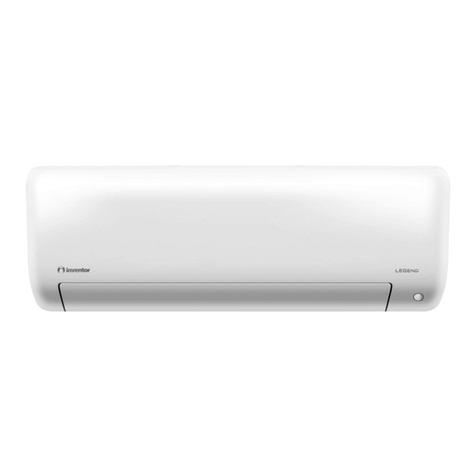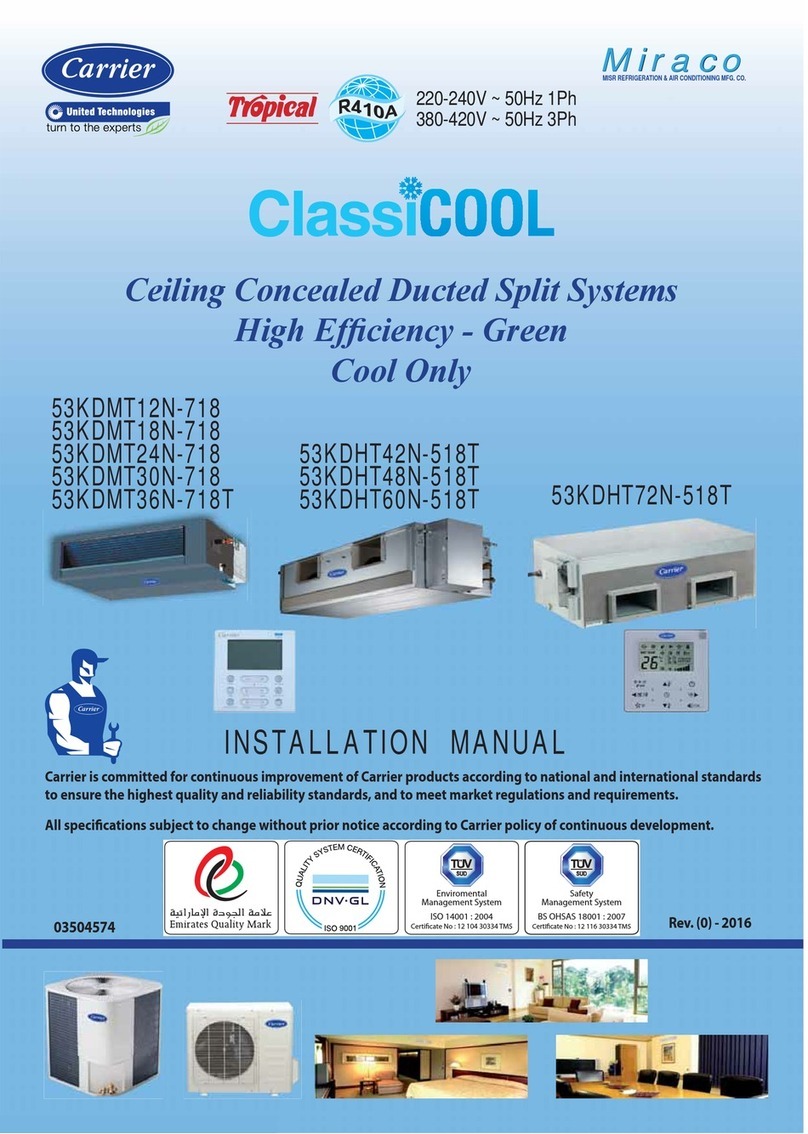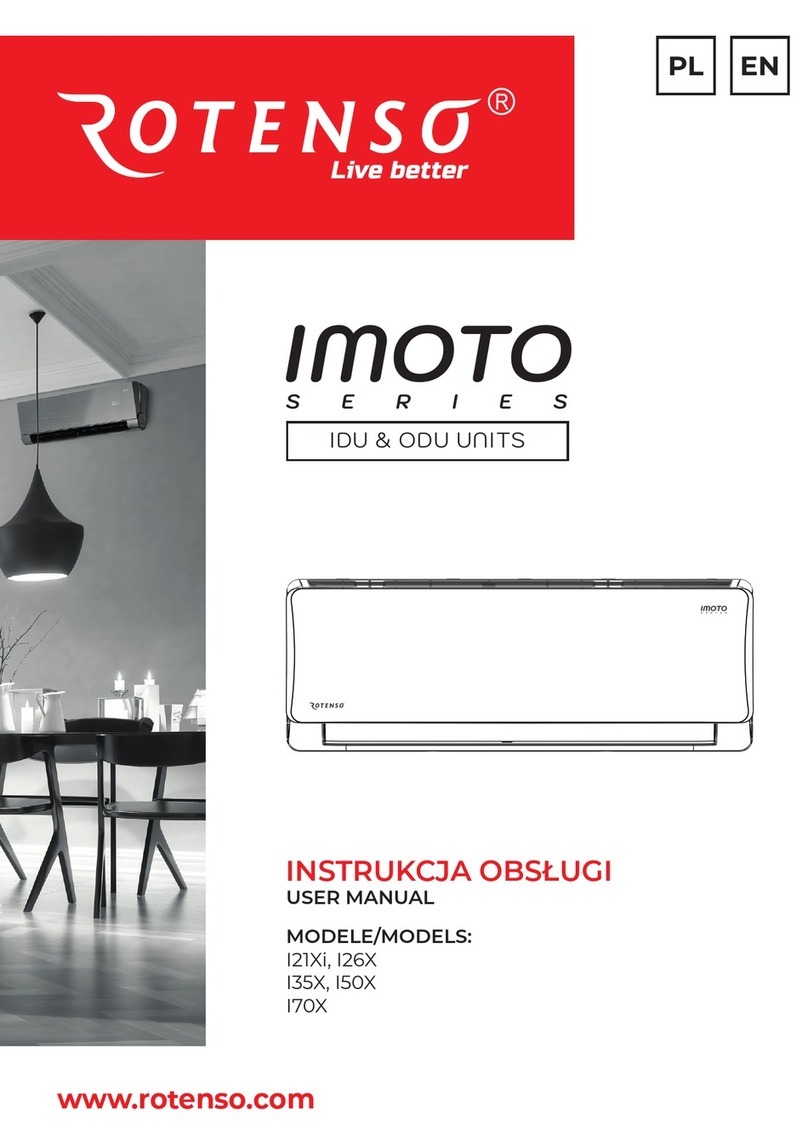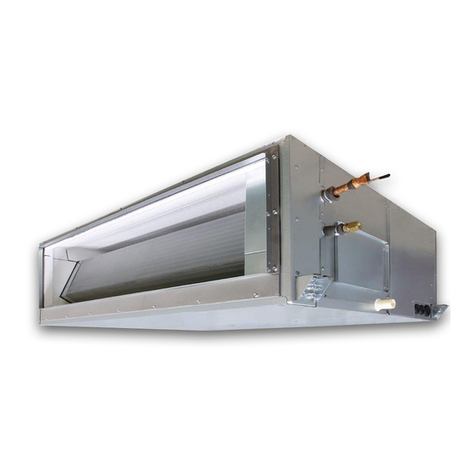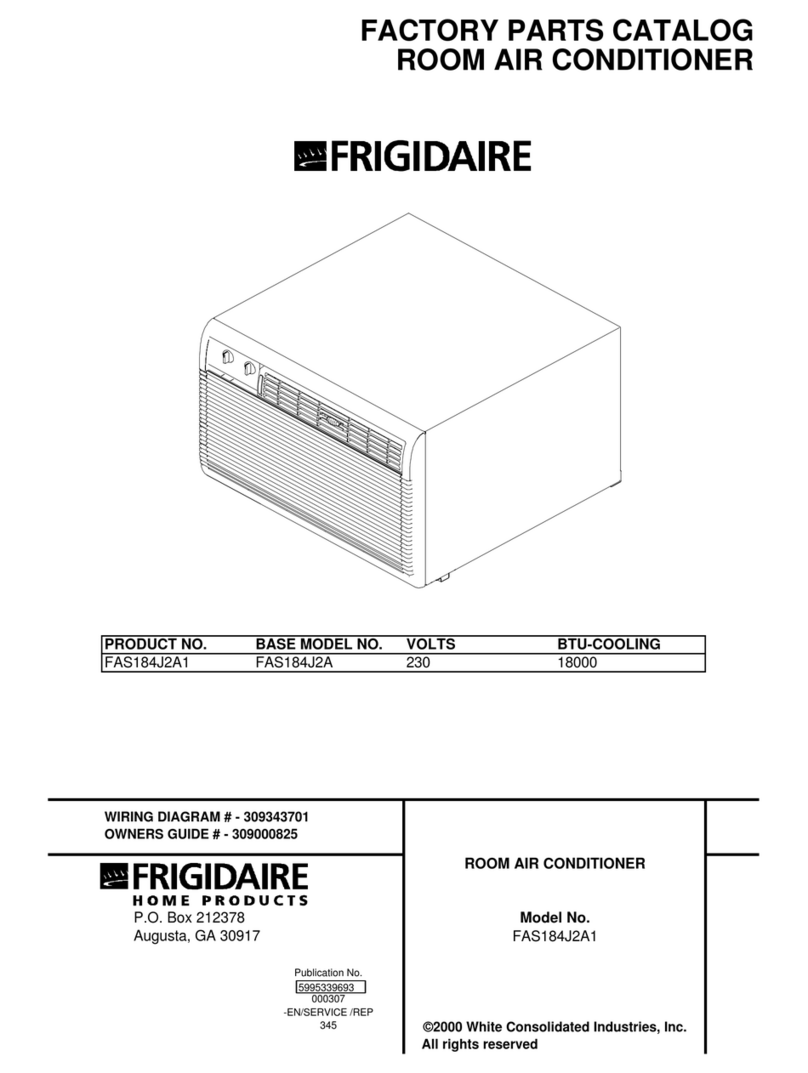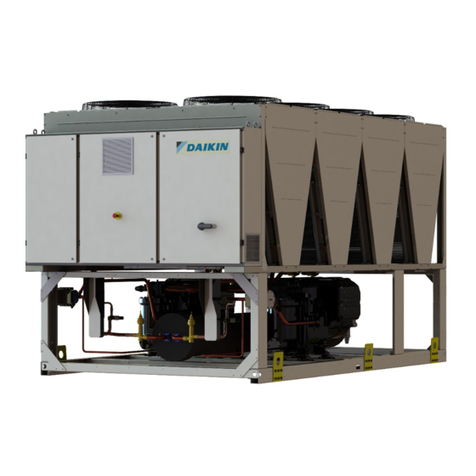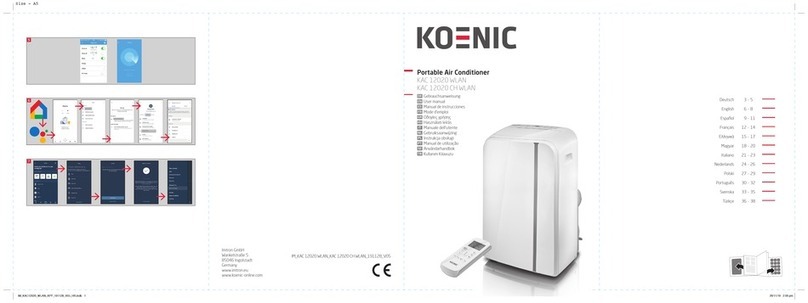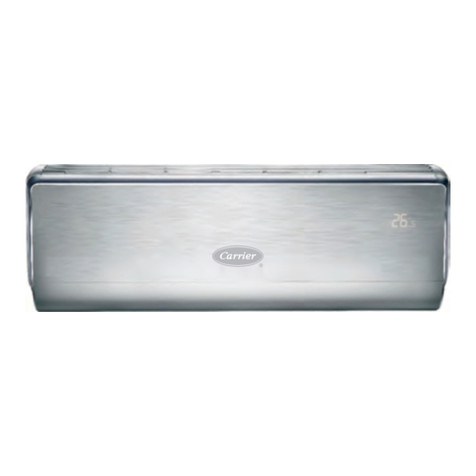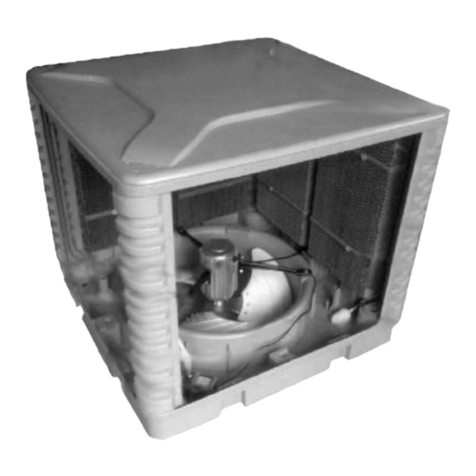J&E Hall V3 FUSION User manual

COMMERCIAL CONDENSING UNITS
TECHNICAL MANUAL
V3 FUSION & FUSION SCROLL
Commercial Condensing Units
Medium & Low Temperature Applications
ISSUE: 01.06.2023
V3

Issue: 01.06.2023 Page II
IMPORTANT!
READ BEFORE PROCEEDING!
GENERAL SAFETY GUIDELINES
This guideline is intended for users to ensure safe installation, operation, and maintenance of J & E Hall Fusion & Fusion scroll
condensing units. This guideline is not intended to replace the system expertise available from the system manufacturers.
This equipment is a relatively complicated apparatus. During installation, operation, maintenance or service, individuals may be
exposed to certain components or conditions including, but not limited to refrigerants, materials under pressure, rotating
components, and both high and low voltage. Each of these items has the potential, if misused or handled improperly, to cause
bodily injury or death. It is the obligation and responsibility of operating/service personnel to identify and recognize these
inherent hazards, protect themselves, and proceed safely in completing their tasks. Failure to comply with any of these
requirements could result in serious damage to the equipment and the property in which it is situated, as well as severe personal
injury or death to themselves and people at the site.
This document is intended for use by owner-authorized operating/service personnel. It is expected that these individuals possess
independent training that will enable them to perform their assigned tasks properly and safely. It is essential that, prior to
performing any task on this equipment, this individual shall have read and understood this document and any referenced mate-
rials. This individual shall also be familiar with and comply with all applicable governmental standards and regulations
pertaining to the task in question.
SAFETY SYMBOLS
The following symbols are used in this document to alert the reader to specific situations:
WARNING
Warning! Risk of serious injury or
death to person!
CAUTION
Caution! Danger which can lead to
serious damages!
NOTICE
Notice! Risk of damage to equipment!
NOTICE
Disposal requirement:
Your refrigeration product is marked with this symbol. This means that electrical and electronic products shall
not be mixed with unsorted household waste. Do not try to dismantle the system yourself: the dismantling of
the refrigeration system, treatment of the refrigerant, of oil and of other parts must be done by a qualified
installer in accordance with relevant local and national legislation. Refrigeration equipment must be treated
at a specialized treatment facility for re-use, recycling and recovery.
By ensuring this product is disposed of correctly, you will help to prevent potential negative consequences for
the environment and human health. Please contact J & E Hall for more information.
Batteries must be removed from the controller if applicable and disposed of separately in accordance with
relevant local and national legislation.

Issue: 01.06.2023 Page 1
Contents
NOMENCLATURE.............................................................1
PRODUCT FEATURES .......................................................1
SPECIFICATIONS ..............................................................1
Table 1: Technical Data.............................................2
PERFORMANCE DATA ..........................................................3
APPLICATION GUIDELINES...............................................3
Table 2: Operating Limit ...........................................3
HEALTH AND SAFETY.......................................................3
GENERAL INFORMATION.......................................................3
INSTALLATION.................................................................4
UNIT LOCATION..................................................................4
Figure 1: Positioning of condensing unit ...................4
Figure 2: Air circulation for condenser ......................4
INSTALLATION CLEARANCES...................................................4
Figure 3: Installation Clearance ................................4
FIELD PIPING......................................................................4
Figure 4: Piping layout for outdoor above indoor .....5
Figure 5: Piping layout for outdoor below indoor .....5
PRESSURE TESTING .............................................................6
Table 3: Maximum working pressure........................6
EVACUATION AND CHARGING................................................6
ELECTRICAL........................................................................6
REVERSE ROTATION PROTECTION AND VOLTAGE UNBALANCE .....7
COMMISSIONING............................................................7
SCROLL COMPRESSOR OPERATION .........................................7
DUAL PRESSURE SWITCH......................................................7
Figure 6: Saginomiya DNS-D306 ...............................7
Figure 7: Adjustment on Danfoss KP17WB ...............8
Figure 8: KP17WB: high pressure reset option.........8
Table 4: Dual Pressure Switch Manufacturer Setting8
PRESSURE SWITCH SETTINGS .................................................8
Table 5: Compressor operating pressures in barg.....8
CRANKCASE HEATERS ..........................................................9
FAN SPEED CONTROLLER XGE-4C .........................................9
Figure 9: Full voltage adjustment on XGE-4C............9
Table 6: FSC settings to obtain ecodesign data.........9
FAN CONTROL SWITCH SYS-C130 .........................................9
Table 7: Fan control switch factory setting ...............9
DISCHARGE THERMOSTAT ....................................................9
VOLTAGE MONITORING DEVICE MG73BF............................10
Table 8: LED indication on front plate of MG73BF..10
VAPOR INJECTION CONTROLLER EXD-HP1............................10
Table 9: Digital input status of EXD-HP1.................10
Figure 10: Display/ keypad unit (LEDs and button
functions) ................................................................11
Table 10: Display parameters .................................11
Table 11: Parameter list for manual mode operation
................................................................................11
Table 12: EXD-HP1 error/ alarm handling...............11
OUTLINE DRAWING.......................................................12
Figure 11: Outline Drawing Series 1........................12
Figure 12: Outline Drawing Series 2........................12
Figure 13: Outline Drawing Series 3........................12
Figure 14: Outline Drawing Series 4........................12
Figure 15: Outline Drawing Series 6........................12
WIRING DIAGRAMS.......................................................13
Figure 16: JEHR-0050-B1-M-1 .................................13
Figure 17: JEHR-0067/0100/0113-B1-M-1..............13
Figure 18: JEHR-0115/0135-B1-L-1 .........................14
Figure 19: JEHR-0140/0170-B2-M-1 .......................14
Figure 20: JEHR-0140/0170-B2-M-3 .......................15
Figure 21: JEHR-0180/0210-B2-L-1 .........................15
Figure 22: JEHR-0180/0210-B2-L-3 .........................16
Figure 23: JEHS-0200/0250/0300/0350-B2-M-1.....16
Figure 24: JEHS-0200/0250/0300/0350-B2-M-3,
JEHS-0300-B2-L-3 ....................................................17
Figure 25: JEHS-0350/0400-B3-M-1........................17
Figure 26: JEHS-0350/0400/0500/0600/0680-B3-M-
3, JEHS-0400/0500/0600-B3-L-3 .............................18
Figure 27: JEHS-0800/1000-B4-M-3........................18
Figure 28: JEHS-1300-B4-M-3, JEHS-1500-B6-M-3..19
Figure 29: JEHS-0750-B4-L-3 ...................................19
Figure 30: JEHS-0951-B4-L-3 EVI .............................20
Figure 31: JEHS-1150-B4-L-3 EVI .............................20
Figure 32: JEHS-1400-B4-L-3 EVI .............................21
SERVICE & MAINTENANCE ............................................22
Table 13: Torque Tightening ...................................23
F-GAS REQUIREMENT....................................................24
Table 14: Tonnes CO
Equivalent ............................24
Table 15: Leak Inspection Frequency ......................24
Table 16: Trouble Shooting .....................................24
Figure 33: Declaration of conformity ......................27
Figure 34: Declaration of incorporation..................29
Figure 35: EU Declaration of conformity.................30
Figure 36: EU Declaration of incorpolation.............32

Issue: 01.06.2023 Page 1
Nomenclature
Product Features
J & E Hall V3 Fusion and Fusion Scroll condensing unit adopt fix speed compressor in a flexible plug and play package, for
medium and low temperature refrigeration application.
Standard features for all medium and low temperature model:
•Tecumseh reciprocating compressors
•Copeland scroll compressors
•Microchannel condenser coil in -B1 and -B2 units
•Liquid receiver with fusible plug
•Fitted liquid line drier & sight glass
•Dual LP/HP Pressure control
•Flexible pressure hoses
•External service valves
•IP rated enclosure
•Combined mains isolator with short circuit / overload protection
•Fuse protection to fan and control circuit
•Fan speed control (except -B1-M-1 units)
•Crankcase heater on compressor (except -B1-M-1 units)
•Alarm output available from high pressure switch
•Acoustic insulation to compressor compartment
Specifications
Indicator:
•Oil Type A: Uniqema Emkarate RL32CF
•Oil Type B: Polyolester Oil - (Copeland Ultra 22 CC, Copeland Ultra 32 CC, Copeland Ultra 32-3MAF, Mobil EAL Arctic
22CC, Uniqema Emkarate RL32CF)
•COP/SEPR according to Ecodesign conditions.
•n/c: not compatible with this refrigerant
•n/a: compatible with this refrigerant but no data available at Ecodesign condition or does not meet Ecodesign requirement
•a NC: Nominal Current rated at condition (-10°C Te / +32°C Ta) for MT and (-35°C Te / +32°C Ta) for LT with R448A
refrigerant.
•b MCC: Maximum Continuous Current
•cLRC: Locked Rotor Current
•d SPL @10m: Sound Pressure Level measured 10m from unit, in an anechoic room rated at (-10°C Te / +32°C Ta) for MT
and (-25°C Te / +32°C Ta) for LT. Alternative conditions may produce different results
•FLC: Full load current of fan
0140-
JEHR -
Approximate Horsepower
0140: 1.4hp
Product Type
JEHR: J & E Hall International Reciprocating
JEHS: J & E Hall International Scroll
B 2 - M - 3
Unit Generation
B: Second Generation
Unit Series
2: Series 2
Application
M: Medium Temperature
L: Low Temperature
Power Supply
1: 230V/1Ph/50Hz
3: 400V/3Ph/50Hz

Issue: 01.06.2023 Page 2
Table 1: Technical Data
Swept
Volume
Oil
Charge
NC a MCCbLRCc
Total
FLC
Liquid
Gas
Unit
(W x Dx H)
Mounting
(W x D)
(m³/h) (Litres) (Litres) (A) (A) (A) (A) (Litres) (Litres) (m³/h) (inch) (inch) (mm) (mm) (kgs) dB(A)
JEHR-0050-B1-M-1 n/c 1.59 1.77 1.66 1.66 1.67 AE4460Z-FZ1C 1.80 0.28 - 3.4 5.9 19.4 1 0.2 0.44 2.4 1250 1/4 3/8 49 28
JEHR-0067-B1-M-1 n/c 1.62 1.76 1.64 1.64 1.67 CAJ9480Z 2.64 0.48 - 3.1 6.7 24.1 1 0.2 0.44 2.4 1250 3/8 1/2 56 28
JEHR-0100-B1-M-1 n/c 1.66 1.77 1.64 1.64 1.68 CAJ9510Z 3.18 0.48 - 3.9 8.4 29.5 1 0.2 0.44 2.4 1250 3/8 1/2 57 28
JEHR-0113-B1-M-1 n/c 1.78 1.85 1.71 1.71 1.73 CAJ9513Z 4.21 0.48 - 4.9 11.3 33.5 1 0.2 0.44 2.4 1250 3/8 1/2 58 28
JEHR-0140-B2-M-1 n/c 1.74 1.93 2.09 2.09 1.92 CAJ4517Z 4.52 0.48 - 5.3 12.7 38.5 1 0.6 0.51 4.5 2700 3/8 1/2 67 32
JEHR-0140-B2-M-3 n/c 1.66 1.85 2 2 1.83 TAJ4517Z 4.52 0.48 - 2.3 4.0 18.0 1 0.6 0.51 4.5 2700 3/8 1/2 67 32
JEHR-0170-B2-M-1 n/c n/c n/c 1.73 1.73 1.65 CAJ4519Z 6.00 0.48 - 6.4 15.2 45.0 1 0.6 0.51 4.5 2700 3/8 5/8 68 33
JEHR-0170-B2-M-3 n/c n/c n/c 1.76 1.76 1.73 TAJ4519Z 6.00 0.48 - 3.1 4.8 22.0 1 0.6 0.51 4.5 2700 3/8 5/8 68 33
JEHS-0200-B2-M-1 1.92 2.18 1.92 2.02 2.02 n/c ZB15KQE-PFJ 5.90 1.30 - 7.3 18.5 58.0 1 0.6 0.51 4.5 2700 3/8 3/4 70 33
JEHS-0200-B2-M-3 2.19 2.12 1.88 2.02 2.02 n/c ZB15KQE-TFD 5.90 1.30 - 2.9 7.0 26.0 1 0.6 0.51 4.5 2700 3/8 3/4 70 33
JEHS-0250-B2-M-1 n/a 2.06 1.83 1.93 1.93 n/c ZB19KQE-PFJ 6.80 1.30 - 9.3 20.5 61.0 1 0.6 0.51 4.5 2700 3/8 3/4 72 34
JEHS-0250-B2-M-3 n/a 1.99 1.83 1.93 1.93 n/c ZB19KQE-TFD 6.80 1.30 - 4.2 7.0 32.0 1 0.6 0.51 4.5 2700 3/8 3/4 72 34
JEHS-0300-B2-M-1 n/a n/a 1.74 1.85 1.85 n/c ZB21KQE-PFJ 8.60 1.45 - 12.2 21.5 82.0 1 0.6 0.51 4.5 2700 3/8 3/4 74 36
JEHS-0300-B2-M-3 n/a 1.92 1.69 1.85 1.85 n/c ZB21KQE-TFD 8.60 1.45 - 4.4 10.3 40.0 1 0.6 0.51 4.5 2700 3/8 3/4 74 36
JEHS-0350-B2-M-1 1.86 n/a n/a (2.72) (2.72) n/c ZB26KQE-PFJ 9.90 1.50 - 14.8 25.0 97.0 1 0.6 0.51 4.5 2700 3/8 3/4 74 39
JEHS-0350-B2-M-3 2.08 n/a n/a (2.72) (2.72) n/c ZB26KQE-TFD 9.90 1.50 - 5.8 9.0 46.0 1 0.6 0.51 4.5 2700 3/8 3/4 74 39
JEHS-0350-B3-M-1 2.13 (3.43) (3.16) (3.02) (3.02) n/c ZB26KQE-PFJ 9.90 1.50 - 13.9 25.0 97.0 1 0.9 4.42 7.6 4250 1/2 3/4 112 37
JEHS-0350-B3-M-3 2.36 (3.48) (3.22) (3.02) (3.02) n/c ZB26KQE-TFD 9.90 1.50 - 5.9 9.0 46.0 1 0.9 4.42 7.6 4250 1/2 3/4 112 37
JEHS-0400-B3-M-1 n/a (3.61) (3.54) (3.13) (3.13) n/c ZB29KQE-PFJ 11.40 1.36 - 16.1 28.0 114.0 1 0.9 4.42 7.6 4250 1/2 7/8 119 37
JEHS-0400-B3-M-3 2.36 (3.79) (3.49) (3.13) (3.13) n/c ZB29KQE-TFD 11.40 1.36 - 7.3 11.0 50.0 1 0.9 4.42 7.6 4250 1/2 7/8 119 37
JEHS-0500-B3-M-3 n/a (3.21) (3.07) (2.97) (2.97) n/c ZB38KQE-TFD 14.40 2.07 - 8.2 13.5 65.5 1 0.9 4.42 7.6 4250 1/2 7/8 123 38
JEHS-0600-B3-M-3 n/a (3.19) (3.12) (3.22) (3.22) n/c ZB45KQE-TFD 17.10 1.89 - 8.7 14.2 74.0 1 0.9 6.89 7.6 4100 1/2 1 1/8 125 40
JEHS-0680-B3-M-3 n/a (2.96) n/a (2.96) (2.96) n/c ZB48KQE-TFD 18.80 1.80 - 11.4 19.1 101.0 1 0.9 6.89 7.6 4100 1/2 1 1/8 126 40
JEHS-0800-B4-M-3 (3.10) (3.12) (2.95) (2.88) (2.88) n/c ZB57KCE-TFD 21.40 1.89 - 9.6 21.3 102.0 2 1.8 8.73 13.6 8500 3/4 1 1/8 204 43
JEHS-1000-B4-M-3 (3.37) n/a n/a (2.83) (2.83) n/c ZB76KQE-TFD 29.10 3.20 - 14.4 28.0 118.0 2 1.8 8.73 13.6 8500 3/4 1 3/8 226 43
JEHS-1300-B4-M-3 (3.09) n/a n/a (2.97) (2.97) n/c ZB95K5E-TFD 36.40 3.37 0.6 20.2 34.0 140.0 2 1.8 12.84 13.6 8200 3/4 1 3/8 238 46
JEHS-1500-B6-M-3 6 (2.96) n/a n/a (2.94) (2.94) n/c ZB114K5E-TFD 43.40 3.37 0.6 24.0 38.0 174.0 2 3.4 19.00 18.0 11340 3/4 1 3/8 1735 x 854 x 1727 1240 x 808 332 48
JEHR-0115-B1-L-1 n/c n/c n/c n/a n/a 1.05 CAJ2446Z 4.55 0.48 - 2.8 8.2 30.0 1 0.2 0.44 2.4 1250 3/8 1/2 59 27
JEHR-0135-B1-L-1 n/c n/c n/c n/a n/a 0.98 CAJ2464Z 6.00 0.48 - 4.6 10.0 40.0 1 0.2 0.44 2.4 1250 3/8 1/2 61 27
JEHR-0180-B2-L-1 n/c n/c n/c 0.96 0.96 1.03 FH2480Z-XC3A 9.45 1.14 0.5 6.1 12.0 65.0 1 0.6 0.51 4.5 2700 3/8 5/8 81 35
JEHR-0180-B2-L-3 n/c n/c n/c 1.00 1.00 1.07 FH2480Z-XG1A 9.45 1.14 0.5 2.5 6.4 31.0 1 0.6 0.51 4.5 2700 3/8 5/8 80 35
JEHR-0210-B2-L-1 n/c n/c n/c 0.99 0.99 0.99 FH2511Z-XC3A 11.83 1.14 0.5 6.7 24.0 71.0 1 0.6 0.51 4.5 2700 3/8 5/8 83 38
JEHR-0210-B2-L-3 n/c n/c n/c 1.00 1.00 1.05 FH2511Z-XG1A 11.83 1.14 0.5 3.4 8.3 60.0 1 0.6 0.51 4.5 2700 3/8 5/8 81 38
JEHS-0300-B2-L-3 n/c n/a n/a 0.97 0.97 n/c ZF09KQE-TFD 8.00 1.50 0.5 3.8 6.5 40.0 1 0.6 0.51 4.5 2700 3/8 3/4 78 33
JEHS-0400-B3-L-3 n/c (1.67) (1.65) (1.67) (1.67) n/c ZF13KQE-TFD 11.80 1.90 0.6 4.9 10.0 51.5 1 0.9 4.42 7.6 4250 1/2 7/8 132 37
JEHS-0500-B3-L-3 n/c (1.67) (1.64) n/a n/a n/c ZF15KQE-TFD 14.50 1.90 0.6 6.7 12.0 64.0 1 0.9 4.42 7.6 4250 1/2 7/8 132 39
JEHS-0600-B3-L-3 n/c (1.64) n/a (1.64) (1.64) n/c ZF18KQE-TFD 17.10 1.90 0.6 7.6 12.5 74.0 1 0.9 4.42 7.6 4250 1/2 7/8 133 41
JEHS-0750-B4-L-3 n/c n/a n/a (1.64) (1.64) n/c ZF25K5E-TFD 21.40 1.90 0.6 6.9 16.6 102.0 2 1.2 4.14 13.6 5750 1/2 1 1/8 203 41
JEHS-0951-B4-L-3 EVI n/c (1.65) (1.74) (1.68) (1.68) n/c ZFI26KQE-TFD 17.10 1.90 0.6 7.3 13.0 74.0 2 1.2 8.73 13.6 5870 1/2 7/8 200 37
JEHS-1150-B4-L-3 EVI n/c (1.68) (1.78) (1.71) (1.71) n/c ZFI36KQE-TFD 21.40 1.90 0.6 8.9 16.6 102.0 2 1.8 8.73 13.6 8500 1/2 1 1/8 211 42
JEHS-1400-B4-L-3 EVI n/c (1.89) n/a (1.67) (1.67) n/c ZF34K5E-TFD 29.10 3.37 0.6 13.7 25.0 100.0 2 1.8 12.84 13.6 8200 1/2 1 3/8 235 44
Unit Model
545 x 400
876 x 430 x 606
940 x 560
1348 x 612 x 1727
B
Low Temperature
4
B
1348 x 612 x 1727
940 x 560
3
1353 x 575 x 872
945 x 500
1
876 x 430 x 606
545 x 400
Airflow
Fan
Compressor
1101 x 444 x 662
703 x 408
Series
COP/ (SEPR)
Compressor
Medium Temperature
4
3
1
R449A
R134a
R407A
R407F
R448A
2
App.
SPL @
10md
Type
R452A
Connections
Oil
Type
Oil Sep.
Charge
1101 x 444 x 662
Unit Dry
Weight
Dimensions
No.
Electrical Data
Coil
Volume
Liquid
Receiver
Volume
A
2
703 x 408
A
1353 x 575 x 872
945 x 500

Issue: 01.06.2023 Page 3
Performance Data
Scan below QR code to access
https://commercial.jehall.co.uk/ to view
performance data, eco design sheet, technical
manual.
Application Guidelines
It should ensure that the refrigeration system
which adopts this condensing unit, wherever
possible to integrate pump down features.
This is to avoid liquid compression which
could damage the compressor.
Ensure that new compressors are not
subjected to liquid abuse. Turn the crankcase
heater on 12 hours before starting the
compressor to avoid oil dilution and bearing
malfunction.
Table 2: Operating Limit
Operating Limits
Recommendation
Maximum discharge
gas temperature
Fusion: 1200C
Fusion scroll: 1300C
Low pressure side
Minimum 0.5barg; Maximum
19barg
High pressure side
Maximum 28barg
Evaporator outlet
superheat
Above 6K (to avoid liquid flood
back)
Suction gas
superheat at
compressor inlet
Not more than 20K
Voltage supply
1phase: Min: 207V, Max: 253V
3phase: Min: 360V, Max: 440V
Phase asymmetry
+/- 2%
Frequency
50Hz +/- 1%
Outdoor ambient
Min: -200C, Max: 430C (except -B1-
M-3, where head pressure control is
recommended to be integrated for
ambient below 100C to avoid
erratic expansion valve operation)
Maximum pipe run
Fusion: 25m
Fusion scroll: 50m
Suction line shall be insulated to avoid:
•High superheat during high ambient condition can
create high discharge temperature.
•Too low superheat during low ambient condition that
can condense refrigerant inside suction line.
Health and Safety
Only qualified personnel, who are familiar
with refrigeration systems and components
including all controls, should perform the
installation and start-up of the system. To
avoid potential injury, use care when working around
coil surfaces or sharp edges of metal cabinets. All piping
and electrical wiring should be installed in accordance
with all applicable standards and local by-laws.
General information
Before Installation
•Ensure the units received are the correct models for the
intended application.
•Ensure the refrigerant, voltage and maximum working
pressure are all suitable for the proposed application.
•Check there is no damage to the units. Any damage
should be reported to the supplier immediately.
•Check that the proposed equipment locations are
suitable and provide adequate support for the weight
of the units.
Offloading and Lifting
•Whenever a condensing unit is lifted, it should be from
the base and, where possible, all packing and
protection is kept in position.
•If lifting equipment is required, ensure that it is suitable,
certificated, and that the operators are qualified to
use it.
•When using a fork-lift or pallet truck to lift the unit, the
two support points should be sufficiently apart to give
stability when lifting and suitably placed to distribute
the load on the forks.
•If slings are used, care should be taken to ensure that
the slings do not crush the casework or coil.
•When lifting by crane, use spreader bars to prevent
compressing the top of the equipment.
•Do not drop the unit. Should this inadvertently happen,
it should be immediately unpacked and inspected for
damage.
•Use the appropriate spreader bars/lifting sling with
the holes and lugs provided.
During Installation and subsequent maintenance
•Installation and maintenance are to be performed only
by qualified personnel who are familiar with local
codes and regulations and experienced with this type
of equipment.
•Safe working methods are identified, and operators
should/must have suitable Personal Protective
Equipment (PPE).
•Ensure the working area has adequate ventilation
during brazing procedures.
•The units contain moving machinery and electrical
power hazards, which may cause severe injury or
death. Disconnect and shut off power before
installation or service of the equipment.
•Refrigerant release into the atmosphere is illegal.
Proper evacuation, recovery, handling, and leak testing
procedures must be observed all the time.
•Units must be grounded to the screw terminal labelled
•No maintenance work should be attempted prior to
disconnecting the electrical supply.
•The electrical covers and fan guards must remain fitted
all the time.
•Use of the units outside of the design conditions and the
application for which the units were intended may be

Issue: 01.06.2023 Page 4
unsafe and be detrimental to the units, regardless of
short or long-term operation.
•The units are not designed to withstand loads or stress
from other equipment or personnel. Such extraneous
loads or stress may cause failure/leak/injury.
•The units are not designed to operate with any
restrictions such as heavy snowfall around them.
Additional measures (such as shielding of the units) shall
be implemented as required.
•The installer must fix the unit securely on installation
using the M8 bolt holes in the unit feet to prevent
instability from accidental contact or from exposure to
the elements (e.g.: wind).
•When the compressor operates under stabilized
conditions, the oil level must be visible in the sight glass.
Foam filling the oil sight glass indicates presence of
large concentration of liquid to the compressor.
•No additional oil is required for installation with good
oil returns, line runs up to 20m. Additional oil might be
required if lines exceeded 20m, with minimum oil level
must not lower than ¼ of sight glass (not applicable to
compressor without sight glass). Top-up the oil while
compressor is idle, via suction schrader connector with a
suitable pump.
•Ensure correct rotation of scroll compressor. If there is
no compression, shut off the incoming power supply
and swap connection of any two of the three incoming
phases at the condensing unit’s motor rated circuit
breaker.
Installation
Unit location
•To achieve maximum cooling capacity, the installation
location for the condensing unit should be carefully
selected.
•Install the condensing unit in such a way so that hot air
ejected by the condensing unit cannot be drawn in
again (short circuit of hot discharge air). Allow
sufficient space for maintenance around the unit.
Figure 1: Positioning of condensing unit
•Ensure that there is no obstruction to air flow into or out
of the unit. Remove obstacles which block air intake or
discharge.
Figure 2: Air circulation for condenser
•The location must be well ventilated, so the unit can
draw in and distribute plenty of air thus lowering the
condensing temperature.
•To optimize the unit running conditions, the condenser
coil must be cleaned at regular intervals.
•The unit must be level in all directions.
•It is recommended to install the unit on rubber grommet
or vibration dampers.
•Wall mounting on brackets is only suitable for models -
B1/-B2/-B3.
Special attention should be given if unit
installed near to the sea as this can reduce
unit lifespan due to corrosion of metal
parts.
Installation clearances
•The installation location should allow sufficient space
for air flow and maintenance around the unit.
Figure 3: Installation Clearance
Field Piping
Pipe sizing should only be determined by
qualified personnel. Correct line sizing will
minimize the pressure drop and maintain
sufficient gas velocity for proper oil return.
All applicable standards must be observed in the
installation of refrigerant piping.
To ensure satisfactory operation and performance, the
following points should be noted:
•Pipework routes must be as simple and as short as
possible.
•Avoid low points on pipework where oil can
accumulate.
•Suction gas velocity must be sufficient to ensure good
oil return.
•Use only clean, dehydrated refrigeration grade
copper tube with long radius bends.
•Avoid flare type connections and take great care when
brazing. Use brazing filler alloys containing phosphorus
such as BCuP-7 without flux for joining copper tubes.
•Dissimilar metals such as copper and brass shall be
joined using an appropriate flux with high silver
content filler material such as BAg-34. Apply flux
sparingly to the clean tube only and in a manner to
avoid leaving any excess inside of completed joints.
✓
✓
X
X

Issue: 01.06.2023 Page 5
•Run braze without over filling to ensure there is no
leakage into the tube.
•To prevent oxidation, blow oxygen free nitrogen
through pipework when brazing.
•To prevent condensation on pipe surface, install
insulation on all suction lines and on all pipes
penetrating walls or passing through hot areas.
•Adequately support all pipe work at a maximum of 2-
meter intervals.
•The maximum rise between the two units should be no
more than 6 meters, to ensure compressor ability to
handle pressure drop.
•In vertical pipework, the use of U-trap and double
suction risers is often required. These suction risers must
always be fitted with a U-trap at the bottom and a P-
trap at the top and never be higher than 4m unless a
second U-trap system is fitted.
•Additional oil may be required if piping length
exceeds 20m or multiple oil traps are fitted. Check the
oil level closely during commissioning and add oil as
necessary. Add oil in small amounts. Do not overfill the
compressor!
•Suction pipework should slope gently back towards the
unit to assist oil return to the compressor. A fall of
approximately 2cm per meter of pipework is
acceptable.
•Liquid lines should be sized to ensure a full supply of
liquid refrigerant to the expansion device. Attention
should be paid to the sizing of liquid lines on large
risers (maximum rise 6m).
•On systems with a large refrigerant charge and
without pump down cycle, or on any system where
liquid flood back is likely to occur, a suction
accumulator (not supplied) is strongly required. It offers
protection against liquid refrigerant flow back during
operation and against off-cycle migration by adding
internal free volume to the suction side of the system.
•Tests must be conducted to ensure the amount of off-
cycle migration to the compressor does not exceed the
compressor’s charge limit.
•Wherever possible the system should be installed to
utilize a pump down configuration.
•Pump down control can be used on all thermostatic
expansion valve systems with the addition of a liquid
line solenoid valve. By closing a liquid line solenoid
valve, the refrigerant can be pumped into the
condenser and receiver, and the compressor operation
controlled by means of a low-pressure control. The
refrigerant can thus be isolated during periods when
the compressor is not in operation, and migration of
refrigerant to the compressor crankcase is prevented.
•In case of fire incidence, pressure increases due to
increasing in temperature at receiver. Hence it is very
important to install the Pressure Relief Valve.
•No valves and detachable joints shall be in areas
accessible to the public except when they comply with
EN 16084.
•Field piping for outdoor unit located below indoor unit:
Inverted P-trap is necessary when pump down is not
used (Figure 5). To prevent refrigerant from draining
into the compressor during off-cycle.
One of the main factors affecting
equipment reliability and compressor
service life is refrigeration circuit
contamination.
During installation, circuit contamination could cause by:
•Brazing & Welding Oxides
•Filings & Particles from de-burring pipework
•Brazing Flux
•Moisture & Air
Figure 4: Piping layout for outdoor above indoor
Figure 5: Piping layout for outdoor below indoor
INDOOR
UNIT
OUTDOOR
UNIT
MAX. 4m MAX. 4m
8 TO 12 m/s
U-TRAP AS SHORT AS POSSIBLE
2cm/m SLOPE,
4m/s OR MORE
SUCTION LINE
LIQUID LINE
2cm/m SLOPE, 4m/s OR MORE
MAX. TOTAL HEIGHT <10M
BULB LOCATION
U-TRAP AS
SHORT AS
POSSIBLE
INVERTED P-TRAP
OUTDOOR
UNIT
INDOOR
UNIT
INVERTED P-TRAP
SUCTION LINE
LIQUID LINE
MAX. RISE 6M
2cm/m SLOPE, 4m/s OR MORE
BULB LOCATION

Issue: 01.06.2023 Page 6
Installation
Pressure Testing
Never use oxygen, dry air, or acetylene for
pressure testing of the system as these may
form an inflammable mixture.
•The condensing units are pressure tested in the factory
prior to dispatch. All units come with a holding charge
of oxygen free nitrogen ~2barg. Remove the holding
charge indication tag which is tied to service valve
before installation.
•Once the pipework installation is complete, it should be
pressure tested for leak prior to evacuation.
•A pressure leak test should be carried out using
oxygen free nitrogen (OFN). A calibrated nitrogen
pressure regulator must always be used. Before
starting any pressure testing, ensure the area
surrounding the system is safe, inform relevant
personnel and fit warning signs indicating high pressure
testing. Also, use correct PPE as required.
•Always pressurize the system slowly, preferably in
stages up to the maximum required pressure. Never
exceed maximum working pressures shown in below
table. Failure to obey the limit will cause premature
failure on the pressure safety device.
Table 3: Maximum working pressure
High Side, barg (psig)
Low Side, barg (psig)
28 (405)
19 (275)
•Listen for any possible leaks and check all joints with
bubble spray. If any leaks are discovered, release
pressure slowly from both suction and liquid line of
system until empty, repair leak and then repeat
pressure testing procedure. Never attempt to repair a
leak on a pressurized system.
•A strength test should also be incorporated (to the
installed pipework only) according to applicable
standards.
•Once testing has been completed satisfactorily, release
the pressure from the system gradually and safely to
external atmosphere.
Evacuation and Charging
Moisture prevents proper functioning of the
compressor and the refrigeration system.
Ensure that a good quality vacuum pump is
used to pull a minimum vacuum of 250
microns (0.25 torr) measured at refrigeration system, and
not at the vacuum pump gauge.
Once pressure testing has been completed, the system
needs to be evacuated to remove any moisture from the
piping. This can be done as follows:
•Ensure any nitrogen charge is safely released from the
system.
•Connect a gauge manifold to the connections on the
service valves on the condensing unit.
•Connect a vacuum pump and vacuum gauge to the
system.
•Ensure all gauge manifold and service valves in open
position.
•Evacuate the system until vacuum is below 250 microns
(0.25 torr).
Note: A triple evacuation procedure is recommended for
all new systems or where moisture is suspected.
•Once the system is isolated and the vacuum pump is
switched off, any rise in pressure indicates that either
there may be a leak in the system or moisture is still
present. In this case, recheck the system for leaks,
repair as necessary, and then repeat the evacuation
procedure.
•Once evacuation is completed satisfactorily, the
vacuum pump and vacuum gauge can be removed. At
this point, the refrigerant charge can be added to the
system as required. Refrigerant blend must be charged
in liquid form to avoid change of chemical properties.
•Ensure an adequate liquid charge (4~5barg) has been
introduced to the high side of the system before
starting the compressor.
•The remaining charge is slowly throttled into suction
side until the installation has reached a level of stable
nominal condition during operation. Charging liquid
into the suction side of the system should ONLY be
done with a metering device. Ensure a minimum
operating pressure 0.5 barg is maintained when
adding refrigerant to the suction side, otherwise
overheating of the compressor may occur. Use
calibrated weighing scales to record the amount of
refrigerant added to the system.
•Stop the filling once obtain sufficient suction superheat
and liquid subcooling, remove the cylinder from circuit.
Refrigerant charge by judging the liquid
sight glass does not guarantee as 100%
correct way.
Electrical
The mains electrical supply to the condensing
unit must be via a suitable motor rated circuit
breaker or fuse. A mains isolator is fitted to
all condensing units. Therefore, an additional
isolator is not required unless site conditions
or regulations dictate differently.
J & E Hall Fusion & Fusion Scroll condensing units require
power supply single or three phase which include Neutral
and an Earth. These systems are not suitable for any other
supply voltages (other than specified in Table 2).
•Mains supply cable type and size must be selected to
suit the application and the electrical installation should
conform to the current local standards.
•Cables to the condensing unit should, wherever
possible, be routed through the cable glands supplied
on the rear of the units.
•Connect the mains supply to the units as per the wiring
diagrams.
•Ensure that the power supply corresponds to the unit
and that the power supply is stable.
•Connect power supply according to the present norm
and legal requirement. Ensure that the unit is properly
connected to the ground.
•3phase scroll compressor: live wires need correctly
terminated at motor rated circuit breaker for the
compressor to rotate in correct direction (compression).

Issue: 01.06.2023 Page 7
•The unit is equipped with a motor circuit breaker with
thermal overload and magnetic trip short circuit
protection for the unit. It was preset from factory and
never set value higher than set current on wiring
diagram.
Reverse Rotation Protection and Voltage
Unbalance
The condensing unit does not include phase protector
except for model JEHS-1400-B4-L-3 EVI; JEHS-1500-B6-
M-3 and JEHS-1300-B4-M-3 units. Thus, it is necessary to
ensure correct scroll compressor rotation and incoming line
voltage variance within +/-2% during commissioning.
3 phase scroll compressors require proper
phase sequence to secure right rotation and
therefore compression.
•Do not use a megohmmeter nor apply power to the
compressor while the system under vacuum as this
may cause internal damage to the compressor.
•Never start the compressor under vacuum (do not
operate the compressor with the low-pressure cut-
out bypassing), as this will cause the rotating part to
overheat very quickly causing premature failure.
•There must be no more than 10 compressor’s start
per hour. A higher number reduces the service life of
the compressor. There is no minimum off time for the
compressors. Adequate minimum run time is
required to ensure proper oil return.
Commissioning
To gain access to the electrical box, turn the motor rated
circuit breaker on the side/front of the unit to the OFF
position and loosen the screws on the left-hand side of the
door. The electrical box is located behind the door. Remove
the screws in the electrical box cover to access components.
Pre startup checks
Before starting the condensing unit, the following checks
should be carried out as a minimum:
•Check electrical supply is correct and all connections
are sound.
•All moving parts are free, and guards are fitted.
•Compressor oil level satisfactory.
•Initial settings for safety switches and fan speed
control.
•Overload set correctly on motor rated circuit breaker.
•All valves are in correct operating position.
•Initial refrigerant charge.
•Crankcase heater energized for a minimum of 12 hours
before compressor start-up.
•Gauge manifold connected to both low and high sides
of system.
Running the unit
•Run the unit and check compressor and condenser fan
operation.
•Check system pressures and temperatures, gas charge
and running currents of motors to ensure correct
operation.
•Check compressor suction superheat. This should be
between 10K and 20K for normal operating
conditions.
•Final adjustment of safety switch settings and fan
speed control.
•Allow the system to run for 3 –4 hours. Check
compressor oil level and top up with the correct oil
type as required. Recheck the compressor oil level
again after 24 hours operation.
•Carry out final leak test and ensure all panels/covers
are fitted and screws tightened.
•Log all information along with the system model and
serial numbers for future reference.
•Ensure that the customer / responsible person is
provided with basic operating instructions and where
electrical isolators are situated in case of emergency.
Scroll Compressor Operation
Scroll compressor motors are designed to run only in one
direction. This is not an issue with single phase compressors
as they will always run in the correct direction. The correct
rotation of a three-phase compressor motor depends on the
connection of the three incoming phases to the unit. Correct
rotation can be determined by a drop in suction pressure
and a rise in discharge pressure when the compressor is
energized. Running the compressor for a short period of
time in reverse direction will have no negative impact but
prolonged running in reverse direction may cause
premature failure. To reverse the rotation of a three-phase
scroll compressor, shut off the incoming power supply to the
unit, swap connection of any two of the three incoming phases
at the unit motor rated circuit breaker, reapply power to the
unit and following compressor restart, recheck operating
pressures.
Compressor rotalock connections
All rotalock connections on compressor models are sealed
with Loctite 554 thread sealant. The connections should be
leak tested at commissioning and during
service/maintenance visits. Refer Table 13 for more
information including recommended tightening torque.
Dual Pressure Switch
The dual pressure switch fitted to condensing units is auto
reset for low pressure side and manual reset for high
pressure (fixed differential) are NOT factory preset for
application.
Figure 6: Saginomiya DNS-D306

Issue: 01.06.2023 Page 8
Adjustment on DNS-D306
•High Pressure Cut Out: Turning the adjusting screw (8)
clockwise to increase the cut-out pressure setting and
vice versa. Lock the spindle with locking plate after
setting.
•Low Pressure Cut in: Turning the range adjusting screw
(2) clockwise to decrease the cut-in pressure setting
and vice versa.
•Low Pressure Differential: Turning the differential
adjusting screw (3) clockwise to increase the
differential pressure setting and vice versa. Lock the
spindle with locking plate after setting.
Figure 7: Adjustment on
Danfoss KP17WB
KP17WB has high pressure convertible reset feature. Insert
screwdriver into the slot on the lock disc and turn it to the
desired reset configuration as shown in Figure 8.
Do not turn the screw on the lock disc as it may damage the
convertible reset mechanism.
Figure 8:
KP17WB:
high pressure reset option
When high pressure trip is changed to auto reset on
KP17WB, the compressor is ready to turn ON when
discharge pressure drops below the setting value of (Cut
Out –Fixed Differential).
When HP switch cut out mode is changed
from Manual to Auto operation, the fitting of
an ART (anti-recycle timer) is recommended
to protect the compressor.
Table 4: Dual Pressure Switch Manufacturer Setting
Series
Model
High (barg)
Low (barg)
Cut
Out
Diff.
(Fixed)
Cut
In
Diff (adj)
1,2
DNS-D306
20
7
3
2
3,4,6
KP17WB
18
4
3
2
Pressure switch settings
Both the LP and HP switch settings must be adjusted to
suit application before starting the unit. Ensure that the
high-pressure setting does not exceed the value shown in
Table 5.
High pressure safety
•The high-pressure safety switch is required to stop the
compressor should the discharge pressure exceed the
compressor’s high side operating pressure.
•The high-pressure switch can be set to lower values
depending on the application and ambient conditions.
Low pressure protection
•The low-pressure protection cut out switch protects the
compressor against deep vacuum operation, a
potential cause of failure due to internal arcing and
operating outside the compressor limits.
•The low-pressure protection cut out should never be set
lower than the min. LP cut out value in Table 5. For
systems without pump-down integrated, the LP switch
signal contact shall be used to energize a low-pressure
safety alarm.
•If a thermostat is used for room temperature control,
and a pump down feature is not integrated, a low-
pressure control of the manual reset type should be
wired in series with the thermostat to serve as a
protection cut-off in the event of loss of refrigerant
charge or other abnormal conditions which resulting in
low suction pressures.
•When used for low temperature operational control,
the low-pressure control should be provided with a low
differential for accurate control. For accuracy,
refrigeration gauges must be used in setting cut-in and
cut-out points, since the indicator on the face of the
pressure switch is not sufficiently accurate for control
purposes.
•Compressor operating pressures should be kept within
the limits in Table 5.
Table 5: Compressor operating pressures in barg
Series
1,2
2,3,4,6
1,2
2,3,4
Application
M*
L*
Compressor
Family
AE/AJ
ZB
AJ/FH
ZF/ZFI
Refrigerant
R407A
R407A
R134a
R448A
R407A
R407F
R407F
R449A
R407F
R448A
R448A
R452A
R448A
R449A
R449A
R449A
R452A
R452A
Min. LP Cut
Out
1.5
2
0.6
0.1
0.3
Max. HP
Cut Out
27.7
18
27.7
LP Range
1.5~8.3
2.0~7.1
0.6~3.8
0.1~3.3
HP Range
13.2~27.7
6.6~15.8
13.2~27.7
*M: Medium Temperature; L: Low Temperature

Issue: 01.06.2023 Page 9
Crankcase Heaters
•Crankcase heater should remain energized during the
compressor off cycles. The initial start in the field is a
very critical period for any new compressor because
all load-bearing surfaces are new and require a short
break-in period to carry high loads under adverse
conditions. Thus, the crankcase heater must be turned
on a minimum of 12 hours before the first-time start, to
prevent oil dilution and bearing stress on initial start-
up.
•To energize the crankcase heater while keeping
compressor OFF, isolate the compressor from circuit by
removing jumper wire which in series with H/L pressure
switch, such as terminal 3-4 in Series 2, and then turn
the motor rated circuit breaker to ON position.
Fan Speed Controller XGE-4C
(Applicable to Series 2/3/4 and 6)
•The fan speed controller is factory set to 19barg
(maximum speed) and cut off when drop below
13barg, for operation with R4*** series refrigerant to
ensure compressor always operates within the unit
operating envelope.
•When operate with R134a, the fan speed controller
setting need to be set to 13bar.
Figure 9: Full voltage adjustment on XGE-4C
•The FSC is set according to Table 6 to gain higher
energy efficiency as published in the Ecodesign data
sheets.
Table 6: FSC settings to obtain ecodesign data
Model
FSC settings (barg, maximum speed)
R407A, R407F, R448A,
R449A, R452A
R134a
S2 except (JEHS-0350-
B2-M; JEHR-0180/210-
B2-L)
19
13
JEHS-0350-B2-M; JEHR-
0180/210-B2-L; S3
10
13
S4 except EVI; S6
10
10
S4 EVI
17
N/A
Fan control switch SYS-C130
(Applicable to Series 1- Low Temperature Model)
•The fan control switch is factory set as Table 7, which is
the same setting to obtain the Eco design data.
•Fan stopped when the pressure drop below fan cut out
pressure.
Table 7: Fan control switch factory setting
Model
Fan control Switch (barg)
Cut in
Differentiate
JEHR-0115/135-B1-L-1
16
7
Fan Cut Out = Cut In –Differentiate
Discharge Thermostat
(Applicable to JEHS-0750-B4-L-3, JEHS-1300-B4-M-3,
JEHS-1500-B6-M-3 and all EVI)
Only scroll models specified above are equipped with
discharge thermostat with specification (cut out = 125±4⁰C,
cut in = 95±5⁰C). The thermostat is connected in series to
dual pressure switches, to disconnect all three phases at
contactor in case of overtemperature.
For other 3phase models, it is recommended to install the
discharge thermostat with cut out temperature not more
than the maximum discharge gas temperature specified
in Table 2.
Overheating could be due to compressor working at high
compression ratio (low evaporating and high condensing
pressure); loss/ inadequate charge; or condenser fan not
working. Time must be allowed for the compressor to cool
down before the thermostat auto reset.
For scroll compressors with motor protection code “F”, an
internal line break motor protector is located at the center
of the Y of the motor windings (motor located in low
pressure dome), to disconnect all three phases in case
overcurrent or overtemperature condition. The protector is
the automatic reset device containing snap action bimetal
switch which reacts to a combination of motor current and
motor windings temperature. When the internal motor
protector has tripped, it will take 30 to 40 minutes to reset
and then the compressor will restart.
On a field application, when the internal motor protector
has tripped, the compressor will stop while each of 3
terminals is still energized, to which either the customer or
serviceman may regard the compressor as fail down.
Therefore, the above-mentioned situation should be taken
into consideration.
Units with microchannel condenser
•Care must be taken during charging a unit where a
microchannel condenser coil is fitted.
•The microchannel coils hold less refrigerant than
traditional fin/tube coils, it is easier to be overcharged,
especially if the system is commissioned during
wintertime which ambient temperature is colder.
•If too much refrigerant is added, this may cause
tripping of the high-pressure switch in warmer weather.
•Always check that the amount of condenser sub cooling
is not excessive which may indicate refrigerant
overcharge.
System operation
•Once the system is correctly charged with refrigerant
and the operating condition is stable, check that the
compressor suction superheat is between 10K~20K
and that the compressor discharge temperature is
between 50°C~ 90°C.
•A compressor suction superheat that is too low may
indicate liquid refrigerant return to the compressor,
1 Turn
~1.5bar
Full voltage adjusting
range
10~25barg
Full voltage set point
(factory setting)
19barg full
speed,
mode: cut
off at Pmin.
Effective proportional
band
6 barg
(fixed)

Issue: 01.06.2023 Page 10
whereas a suction superheat that is too high will not
provide enough cooling effect for the compressor and
will cause high discharge temperatures. In either case,
it is likely that compressor damage/failure will occur.
Precautions when operate with FH and AJ
Compressor
Follow instructions below when operating R448A/R449A in
low temperature condensing unit which integrated with
Tecumseh compressor FH/AJ.
Limit the suction superheat below 10K, to
ensure discharge temperature is maintained
below 120ºC with evaporating temperature
of -30ºC and below. Do not use capillary
tubes as throttling devices to prevent plugging issue.
Voltage Monitoring Device MG73BF
(Applicable to JEHS-1400-B4-L-3 EVI; JEHS-1300-B4-M-3
and JEHS-1500-B6-M-3 units only)
Only the above models are equipped with voltage
monitoring device to monitor the input power supply to
protect the 3-phase compressor from overheating as result
of working under phase lost, undervoltage or overvoltage.
Table 8: LED indication on front plate of MG73BF
LED
(ON/OFF)
Condition
ON
UV
OV
BLINK:
ASY, ON:
REV
Power ON
ON
OFF
OFF
OFF
Phase reverse
ON
OFF
OFF
ON
Asymmetry
ON
OFF
OFF
BLINK
Under voltage
ON
ON
OFF
OFF
Over voltage
ON
OFF
ON
OFF
Phase Fail
BLINK
OFF
OFF
OFF
Phase Fail when
input voltages lower
than UV set point
and below
asymmetry
BLINK
ON
OFF
BLINK
Neutral Fail
ON
BLINK
BLI
NK
BLINK
The off-delay timer will turn the system off after a set
amount of time for following situation:
•Supply phases exceed over
voltage or under voltage trip
level setting
•Any supply phase failure
•Line interruption
•Phase reverse occurrence
•Neutral failure
Vapor Injection Controller EXD-HP1
(Applicable to EVI units only)
The controller EXD-HP1 used in the EVI units operates as an
economizer control. The setting of the controller is factory
pre-set and is password protected. Users are not
recommended to change any settings in the controller.
Electronic expansion valves in the EVI unit
are in partially open condition. Do not
charge the system with refrigerant before
closure of valve.
Four main parameters Password (H5), type of function
(1uE), refrigerant type (1u0) and pressure sensor type (1uP)
can be set only when digital input DI1 is off
(open) while the power supply is ON (24Vac).
Digital input Di1
•The digital status is dependent on the operation of
system’s compressor or demand.
Table 9: Digital input status of EXD-HP1
Operating Condition
Di1 status
Compressor starts
Closed (Start)
Compressor stops
Open (Stop)
Electrical checked/modified before start-up
•To fully close the EEV, open circuit Di1-gnd of controller
through disconnecting the supply to compressor. For
1. Model JEHS-0951/1150-B4: remove the jumper
wire from terminal block labeled 8 and 9.
2. Model JEHS-1300-B5: remove twin jumper bars
from terminal blocks labelled 6 and 7.
•Switch ON the motor rated circuit to turn ON the power
supply 24V to the controller EXD-HP1. The valve will
be driven to a close position.
•After closure of the EEV valve, start charging the
system with refrigerant.
•Disconnect power supply through motor rated circuit
breaker, then reconnect back the original wiring from
factory.
•Do not apply voltage to the system before all cable
connections are completed.
•Use a class II category transformer for 24 Vac power
supply. Do not ground the 24 Vac lines.
•Higher voltage than specified will permanently
damage the controller.
•When connecting wires of EEV and pressure sensor
4~20mA to the controller EXD-HP1, follow the cable
color to connect to the respective abbreviation color
code printed on the EXD-HP1. Example for EXV: BR =
Brown; BL = Blue etc. Or refer to wiring diagram for
electrical connections.

Issue: 01.06.2023 Page 11
Figure 10: Display/ keypad unit (LEDs and button
functions)
•In the case of economizer control. The discharge
temperature is shown on the display.
•To display other MEASURED DATA on EXD-HP1, press
“SEL” button for 1 second until index number according to
below table appears. Release “SEL” button and the next
variable data will be displayed. Repeating the
procedure to view all variable data in sequence:
Table 10: Display parameters
Display Index
Variable Data
10
Default Superheat, K
11
Suction pressure, bar
12
Valve position, %
13
Suction gas temperature, °C
14
Saturation temperature, °C
15
Discharge temperature, °C
Note: After 30minutes, the display reverts to index 10.
Manual mode operation
•Manual mode is intended for temporary operation of
the valve at specific condition. Warning: All alarms are
disabled during manual operation. We do not
recommend unattended operation of the system during
manual control.
•Press and together for 5seconds to access to
manual mode operation.
•After achieving the required operation, set the
parameter 1Ho and 1HP at 0, so the controller
automatically operates the valve at its setpoints.
•List of parameters in scrolling sequence by pressing
button
Table 11: Parameter list for manual mode operation
Code
Parameter description
and choices
Min
Max
Factory
setting
1Ho
Manual mode
operation; circuit 1
0 = off 1 = on
0
1
0
1HP
Valve Opening (%)
0
100
0
Manual alarm reset clearing functional alarms (except
hardware error)
•Press and together for 5seconds. When the
clearing is done, “CL” message appears for 2 seconds.
Table 12: EXD-HP1 error/ alarm handling
Note: When multiple alarms occur, the highest priority alarm is displayed until being cleared. Then the next highest alarm is displayed
until all alarms are cleared. Then, the parameters will be shown again.

Issue: 01.06.2023 Page 12
Outline Drawing
Figure 11: Outline Drawing Series 1
Figure 12: Outline Drawing Series 2
Figure 13: Outline Drawing Series 3
Figure 14: Outline Drawing Series 4
Figure 15: Outline Drawing Series 6

Issue: 01.06.2023 Page 13
Wiring Diagrams
Figure 16: JEHR-0050-B1-M-1
Figure 17: JEHR-0067/0100/0113-B1-M-1
L N
I >I >
2
B1 1
BRN
I >
4 6
3 5
BLU
BLU
PE
NOTE 1:ONLY FOR NON PUMP DOWN SYSTEM, REMOVE LINK WIRE FROM
TERMINALS 2 & 3 TO CONNECT EXTERNAL THERMOSTAT FOR CONTROLLING
THE COMPRESSOR ACTIVATION.
INDICATOR:
-- : FIELD WIRING
B1: MOTOR CIRCUIT BREAKER
C1: START CAPACITOR
C2: FAN CAPACITOR
F1U: FUSE
K1R: START RELAY
M1C: COMPRESSOR
M1F: CONDENSER FAN
S1PH: HIGH PRESSURE SWITCH
S1PL: LOW PRESSURE SWITCH
Q1M: MOTOR OVERLOAD PROTECTOR
M1C
CR
S
M
1~
12N
C1
BLU
BLK
GRN/YLW
I>K1R
BLU
Q1M
220-240V 1~ 50Hz
BRN
MODEL B1 SETTING,(A)
JEHR-0050-B1-M-1 6.0
1
P>
LP
1
P<
4
HP
3S1PH
S1PL
2
N2 N1
ALM
BLK
F1U
3.15A
MAX 50VA
GRN/YLW
GRY
M1F
GRN/YLW
1~
M
C2
WHT
PPL
RED
BRN
3
BRN
BLU
BRN
BRN
NOTE 1
L N
I >I >
2
B1 1
BRN
I >
4 6
3 5
BLU
BLU
1
P>
LP
1
P<
4
HP
3S1PH
S1PL
RED
2
N2 N1
ALM
BLK
F1U
3.15A
BRN
MAX 50VA
NOTE 1:ONLY FOR NON PUMP DOWN SYSTEM, REMOVE LINK WIRE FROM
TERMINALS 2 & 3 TO CONNECT EXTERNAL THERMOSTAT FOR CONTROLLING THE
COMPRESSOR ACTIVATION.
INDICATOR:
-- : FIELD WIRING
B1: MOTOR CIRCUIT BREAKER
C1: START CAPACITOR
C2: RUN CAPACITOR
C3: FAN CAPACITOR
F1U: FUSE
K1R: START RELAY
M1C: COMPRESSOR
M1F: CONDENSER FAN
S1PH: HIGH PRESSURE SWITCH
S1PL: LOW PRESSURE SWITCH
Q1M: MOTOR OVERLOAD PROTECTOR
GRN/YLW
GRY
MODEL B1 SETTING,(A)
JEHR-0067-B1-M-1 6.5
JEHR-0100-B1-M-1 7.5
JEHR-0113-B1-M-1 9.5
PE
220-240V 1~ 50Hz
M1F
GRN/YLW
1~
M
C3
WHT
PPL
RED
BRN
3
BRN
BLU
BRN BRN
BRN
BLU
M1C
CR
M
1~
BLK
GRN/YLW
Q1M
S
K1R
2
51
C2
C1
4
BRN
BLU
BLK
BLU
BLU
BLK
NOTE 1

Issue: 01.06.2023 Page 14
Figure 18: JEHR-0115/0135-B1-L-1
Figure 19: JEHR-0140/0170-B2-M-1
GRN/YLW
A1
A2
K1M
L N
BLU
BLU
N2
I >I >
2
B1 1
BRN
BLK
642
I >
4 6
3 5
BRN
BLU
K1M 1
BRN
3 5
1
BLK
BLU
BRN
BRN
F1U
3.15A
BRN
ORG
BLU
N1
ORG
22
K1M
21
GRN/YLW
HP
P
31
5
BLU
E1HC
S1PH
S1P
PE
BLU
2
3
BRN
ALM GRY
220-240V 1~ 50Hz
MODEL B1 SETTING,(A)
JEHR-0115-B1-L-1 6.0
JEHR-0135-B1-L-1 7.5
NOTE 1:ONLY FOR NON PUMP DOWN SYSTEM, REMOVE LINK WIRE FROM TERMINALS 2 & 3 TO CONNECT
EXTERNAL THERMOSTAT FOR CONTROLLING THE COMPRESSOR ACTIVATION.
INDICATOR:
-- : FIELD WIRING
B1: MOTOR CIRCUIT BREAKER
C1: START CAPACITOR
C2: RUN CAPACITOR
C3: FAN CAPACITOR
E1HC: CRANKCASE HEATER
F1U: FUSE
K1M: CONTACTOR
K1R: START RELAY
M1C: COMPRESSOR
M1F: CONDENSER FAN
S1P: FAN PRESSURE SWITCH
S1PH: HIGH PRESSURE SWITCH
S1PL: LOW PRESSURE SWITCH
Q1M: MOTOR OVERLOAD PROTECTOR
S1PL LPP>
4
P< HP
1
3
NOTE 1
RED
BLU
M1C
CR
M
1~
BLK
GRN/YLW
Q1M
S
K1R
2
51
C2
C1
4
BRN
BLK
BLU
BLU
BLK
BRN
M1F
GRN/YLW
1~
M
C3
WHT
PPL
RED
M1F
E1HC
21
22
GRN/YLW
GRN/YLW
ORG
N1
GRN/YLW
1~
M
N3
BLK
C3
1
ORG
A2
N2
K1M
BLU
A1
1
LP
BLK
3
P>
A1P
2
ALM
F1U
3.15A BRN
BLU
S1PH
GRY
4
P< HP
1
3
K1M
14
BRN
BLK
2
BLK
(4)
BLK
RED
K1R
BLU
M1C
220-240V 1~ 50Hz
L N
A/S
2
C/CP/R
M
1~
K1M
BRN
BLU
I >I >
42
I >
B1 1 3
BLU
6
51
C2
C1
5
2 4
BRN
1 3
BLU
4
BLK
BRN
BLU
BLK
BLU
(1)
(2N)
BLK
NOTE 1:ONLY FOR NON PUMP DOWN SYSTEM, REMOVE LINK WIRE FROM TERMINALS 1 & 2 TO CONNECT
EXTERNAL THERMOSTAT FOR CONTROLLING THE COMPRESSOR ACTIVATION.
INDICATOR:
-- : FIELD WIRING
( ): TERMINAL IN COMPRESSOR ELECTRICAL BOX
A1P: FAN SPEED CONTROLLER
B1: MOTOR CIRCUIT BREAKER
C1: START CAPACITOR
C2: RUN CAPACITOR
C3: FAN CAPACITOR
E1HC: CRANKCASE HEATER
F1U: FUSE
K1M: CONTACTOR
K1R: START RELAY
M1C: COMPRESSOR
M1F: CONDENSER FAN
S1PH: HIGH PRESSURE SWITCH
S1PL: LOW PRESSURE SWITCH
Q1M: MOTOR OVERLOAD PROTECTOR
S1PL
13
PE
BLU
K1M
MAX 50 VA
(3L)
BRN
BRN
GRN/YLW
BLU
Q1M
NOTE 1
MODEL B1 SETTING,(A)
JEHR/JEHCCU0140B(C)M1 10.0
JEHR/JEHCCU0170B(C)M1 11.0

Issue: 01.06.2023 Page 15
Figure 20: JEHR-0140/0170-B2-M-3
Figure 21: JEHR-0180/0210-B2-L-1
M1F
E1HC
21
22
GRN/YLW
GRN/YLW
BLK
N2
GRN/YLW
1~
BRN
M
N3
BLU
BLK
C3
1
BLK
A2
BLU
N1
K1M
BLU
BLU
A1
3
BLK
5
A1P
2
ALM
F1U
3.15A BRN
BLU
S1PH
GRY
K1M
K1M
13
14
BRN
BRN
BLK
4
BLK
BRN
1
2
BRN(BLK)
RED
K1R
BLU
M1C
220-240V 1~ 50Hz
L N
S
2
CR
M
1~
BLU
K1
BRN
BLU
I >I >
42
I >
B1 1 3
BLU
BRN
6
51
C2
C1
5
2 4
BRN
1 3
BLU
S1PL
MAX 50 VA
GRN/YLW
BLK
(4)
BLU
BRN
MODEL B1 SETTING,(A)
JEHR/JEHCCU0180B(C)L1 11.0
JEHR/JEHCCU0210B(C)L1 12.0
LPP>
4
P< HP
1
3
NOTE 1
PE
NOTE 1:ONLY FOR NON PUMP DOWN SYSTEM, REMOVE LINK WIRE FROM TERMINALS 3 & 4 TO CONNECT
EXTERNAL THERMOSTAT FOR CONTROLLING THE COMPRESSOR ACTIVATION.
INDICATOR:
-- : FIELD WIRING
( ): TERMINAL IN COMPRESSOR ELECTRICAL BOX
A1P: FAN SPEED CONTROLLER
B1: MOTOR CIRCUIT BREAKER
C1: START CAPACITOR
C2: RUN CAPACITOR
C3: FAN CAPACITOR
E1HC: CRANKCASE HEATER
F1U: FUSE
K1M: CONTACTOR
K1R: START RELAY
M1C: COMPRESSOR
M1F: CONDENSER FAN
S1PH: HIGH PRESSURE SWITCH
S1PL: LOW PRESSURE SWITCH
380-415V 3N~ 50Hz
L2
L1
I >
B1
42 6
I >
1 3
I >
5
M
3~
M1C
K1M
BRN
2 4 6
1 3 5
M1F
E1HC
21
22
GRN/YLW
GRN/YLW
ORG
N2
GRN/YLW
1~
M
N3
1
ORG
A2
BLU
N1
K1M
BLU
BLU
A1
3
BLK
A1P
2
ALM
F1U
3.15A BRN
BLU
S1PH
GRY
K1M
N
L3
13
14
BRN
BLK
GRY
BRN
4
BLK
S1PL
MAX 50 VA
BLU
C/C
P/R
A/S
RD
BLK
BLU
3
K1M
14
13
BRN
GRN/YLW
BLK
BRN
1
2
BRN
BLU
C1
BLK
MODEL B1 SETTING,(A)
JEHR/JEHCCU0140B(C)M3 4.0
JEHR/JEHCCU0170B(C)M3 5.0
PE
LPP>
4
P< HP
1
3
NOTE 1:ONLY FOR NON PUMP DOWN SYSTEM, REMOVE LINK WIRE FROM TERMINALS 3 & 4 TO CONNECT
EXTERNAL THERMOSTAT FOR CONTROLLING THE COMPRESSOR ACTIVATION.
INDICATOR:
-- : FIELD WIRING
( ): TERMINAL IN COMPRESSOR ELECTRICAL BOX
A1P: FAN SPEED CONTROLLER
B1: MOTOR CIRCUIT BREAKER
C1: FAN CAPACITOR
E1HC: CRANKCASE HEATER
F1U: FUSE
K1M: CONTACTOR
M1C: COMPRESSOR
M1F: CONDENSER FAN
S1PH: HIGH PRESSURE SWITCH
S1PL: LOW PRESSURE SWITCH
NOTE 1

Issue: 01.06.2023 Page 16
Figure 22: JEHR-0180/0210-B2-L-3
Figure 23: JEHS-0200/0250/0300/0350-B2-M-1
380-415V 3N~ 50Hz
L2
L1
I >
B1
42 6
I >
1 3
I >
5
BLK
BRN
GRY
M
3~
M1C
K1M
BRN
2 4 6
1 3 5
M1F
E1HC
21
22
GRN/YLW
GRN/YLW
BLK
N2
GRN/YLW
1~
BRN
M
N3
BLU
BLK
C1
1
BLK
A2
BLU
N1
K1M
BLU
BLU
A1
3
BLK
5
A1P
2
ALM
F1U
3.15A BRN
BLU
S1PH
GRY
K1M
N
L3
13
14
K1M
13
14
BRN
BRN
BLK
GRY
BRN
BLK
4
BLK
BRN
1
2
S1PL
MAX 50 VA
GRN/YLW
MODEL B1 SETTING,(A)
JEHR/JEHCCU0180B(C)L3 4.0
JEHR/JEHCCU0210B(C)L3 5.5
NOTE 1:ONLY FOR NON PUMP DOWN SYSTEM, REMOVE LINK WIRE FROM TERMINALS 3 & 4 TO CONNECT
EXTERNAL THERMOSTAT FOR CONTROLLING THE COMPRESSOR ACTIVATION.
INDICATOR:
-- : FIELD WIRING
A1P: FAN SPEED CONTROLLER
B1: MOTOR CIRCUIT BREAKER
C1: FAN CAPACITOR
E1HC: CRANKCASE HEATER
F1U: FUSE
K1M: CONTACTOR
M1C: COMPRESSOR
M1F: CONDENSER FAN
S1PH: HIGH PRESSURE SWITCH
S1PL: LOW PRESSURE SWITCH
NOTE 1
LPP>
4
P< HP
1
3
PE
21
22
GRN/YLW
GRN/YLW
BLK
N2
GRN/YLW
1~
BRN
M
N3
BLU
BLK
C2
1
BLK
A2
BLU
N1
BLU
BLU
A1
3
BLK
5
2
ALM
3.15A BRN
BLU
GRY
K1M
13
14
BRN
BRN
BLK
4
BLK
BRN
1
2
220-240V 1~ 50Hz
L N
BRN
BLU
I >I >
42
I >
B1 1 3
BLU
6
5
2 4
BRN
1 3
BLU
GRN/YLW
1~
C1
BRN
R
BLU
BLK
CS
M
BRN
MAX 50 VA
E1HC
S1PH
S1PL
K1M
F1U
K1M
A1P
M1C M1F
K1M
GRN/YLW
MODEL B1 SETTING,(A)
JEHS/JEHSCU0200B2(C)M1 13.0
JEHS/JEHSCU0250B2(C)M1 13.0
JEHS/JEHSCU0300B2(C)M1 17.0
JEHS/JEHSCU0350B2(C)M1 21.0
NOTE 1:ONLY FOR NON PUMP DOWN SYSTEM, REMOVE LINK WIRE FROM TERMINALS 3 & 4 TO CONNECT
EXTERNAL THERMOSTAT FOR CONTROLLING THE COMPRESSOR ACTIVATION.
INDICATOR:
-- : FIELD WIRING
A1P: FAN SPEED CONTROLLER
B1: MOTOR CIRCUIT BREAKER
C1: RUN CAPACITOR
C2: FAN CAPACITOR
E1HC: CRANKCASE HEATER
F1U: FUSE
K1M: CONTACTOR
M1C: COMPRESSOR
M1F: CONDENSER FAN
S1PH: HIGH PRESSURE SWITCH
S1PL: LOW PRESSURE SWITCH
LPP>
4
P< HP
1
3
PE
NOTE 1

Issue: 01.06.2023 Page 17
Figure 24: JEHS-0200/0250/0300/0350-B2-M-3, JEHS-0300-B2-L-3
Figure 25: JEHS-0350/0400-B3-M-1
L2
L1
I >
B1
42 6
I >
1 3
I >
5
BLK
BRN
GRY
M
3~
M1C
K1M
BRN
2 4 6
1 3 5
M1F
E1HC
21
22
GRN/YLW
GRN/YLW
BLK
N2
GRN/YLW
1~
BRN
M
N3
BLU
BLK
C1
1
BLK
A2
BLU
N1
K1M
BLU
BLU
A1
3
BLK
5
A1P
2
ALM
F1U
3.15A BRN
BLU
GRY
K1M
N
L3
13
14
K1M
13
14
BRN
BRN
BLK
GRY
BRN
BLK
4
BLK
BRN
1
2
T1 T2 T3
GRN/YLW
S1PH
S1PL
MAX 50 VA
GRN/YLW
PE
NOTE 1
LPP>
4
P< HP
1
3
MODEL B1 SETTING,(A)
JEHS/JEHSCU0200B2(C)M3 5.5
JEHS/JEHSCU0250B2(C)M3 7.0
JEHS/JEHSCU0300B2(C)M3 7.5
JEHS/JEHSCU0350B2(C)M3 9.5
JEHS/JEHSCU0300B2(C)L3 6.5
NOTE 1:ONLY FOR NON PUMP DOWN SYSTEM, REMOVE LINK WIRE FROM TERMINALS 3 & 4 TO CONNECT
EXTERNAL THERMOSTAT FOR CONTROLLING THE COMPRESSOR ACTIVATION.
INDICATOR:
-- : FIELD WIRING
A1P: FAN SPEED CONTROLLER
B1: MOTOR CIRCUIT BREAKER
C1: FAN CAPACITOR
E1HC: CRANKCASE HEATER
F1U: FUSE
K1M: CONTACTOR
M1C: COMPRESSOR
M1F: CONDENSER FAN
S1PH: HIGH PRESSURE SWITCH
S1PL: LOW PRESSURE SWITCH
E1HC
22
21
BLK
N3
BLK
A2
BLU
N2
K1M
BLU
BLU
N1
A1
BLK
BLK BLK
ALM
F1U
3.15A BRN
BLU
GRY
K1M
MAX 50 VA
S1PH
GRN/YLW
5
1
BRN
L N
BRN
BLU
I >I >
42
I >
B1 1 3
BLU
6
5
2 4
1 3
BRN
BLU
K1M
C1
BRN
BLU
BLK BRN
1~
RC
S
M
M1C
GRN/YLW
4
3
K1M 14
13
BLU
BRN
GY
GY
Y/G
BL
BR
BK
M
~
C2
GRN/YLW
BRN
BRN
GRN/YLW
BLK
1
A1P
2
2
B
C
A
D
PE
S1PL
GRN/YLW
BRN
220-240V 1~ 50Hz
PE
P<
P>
NOTE 1:ONLY FOR NON PUMP DOWN SYSTEM, REMOVE LINK WIRE FROM TERMINALS 3 & 4 TO CONNECT
EXTERNAL THERMOSTAT FOR CONTROLLING THE COMPRESSOR ACTIVATION.
INDICATOR:
-- : FIELD WIRING
A1P: FAN SPEED CONTROLLER
B1: MOTOR CIRCUIT BREAKER
C1: RUN CAPACITOR
C2: FAN CAPACITOR
E1HC: CRANKCASE HEATER
F1U: FUSE
K1M: CONTACTOR
M1C: COMPRESSOR
M1F: CONDENSER FAN
S1PH: HIGH PRESSURE SWITCH
S1PL: LOW PRESSURE SWITCH
NOTE 1
MODEL B1 SETTING,(A)
JEHS-0350-B3-M-1 21.0
JEHS-0400-B3-M-1 24.5
This manual suits for next models
42
Table of contents
Popular Air Conditioner manuals by other brands

Perfectly Green
Perfectly Green Smart Frog owner's manual

Daikin
Daikin RXG25CVMB Technical data

Nordyne
Nordyne 16 SEER series User's manual & installation instructions

Airwell
Airwell AWSI-HMF009-N61 Service manual
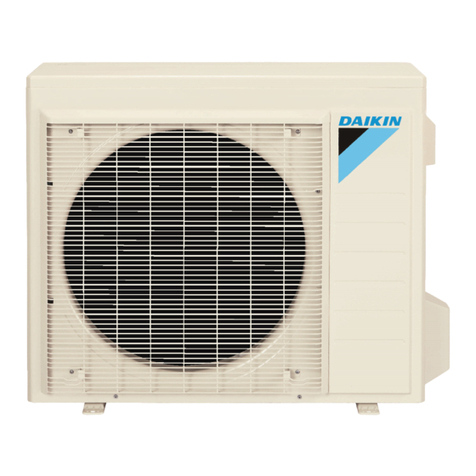
Daikin
Daikin RXL18UMVJU installation manual
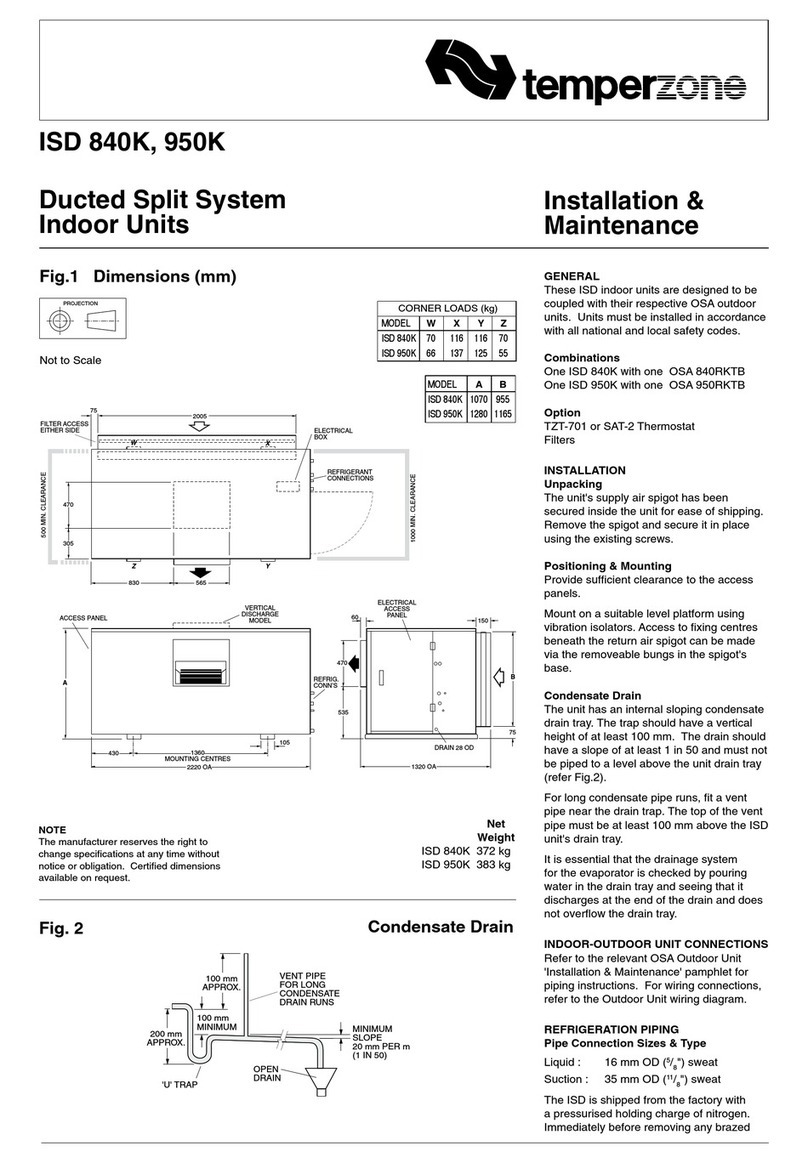
TemperZone
TemperZone ISD 840K Installation & maintenance
